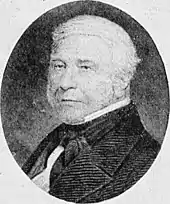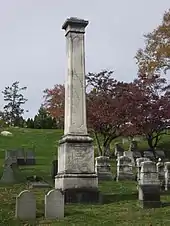William Robinson Jr.
William Robinson Jr. (17 December 1785 – 25 February 1868) was an American politician, business executive, and militia general active in Allegheny, Pennsylvania, now the North Side of Pittsburgh. He was the first mayor of Allegheny and a state legislator.

Early life
Robinson was born on 17 December 1785 in a log cabin in the area soon to become Allegheny. He was reputedly the first white child born west of the Allegheny River.[1] His parents were James Robinson, who operated a ferry across the river, and Martha Boggs Robinson.[1] William was styled "Junior" to distinguish him from an uncle of the same name.[1] After schooling at Pittsburgh Academy (now the University of Pittsburgh) and Princeton University,[1] he read law under ex-senator James Ross, but did not go on to practice the profession.[2]
In 1806, on a flatboat trip down the Ohio River, the young Robinson and several companions were detained on suspicion of taking part in the Aaron Burr conspiracy to found a Southwestern empire. They were released as nothing treasonous could be proven against them.[3]
Business
Robinson managed a number of companies over his lifetime. He was the first president of the Allegheny Bridge Company, which built a bridge over the Allegheny River at the site of his father's ferry crossing (now the site of Pittsburgh's Roberto Clemente Bridge).[1] Opened in 1819,[4] the bridge was the first to cross the Allegheny at Pittsburgh.[5] Robinson was the first president of the Ohio and Pennsylvania Railroad, which became part of the Pittsburgh, Fort Wayne and Chicago Railway, a major component of the Pennsylvania Railroad system.[5] He served for 16 years as the first president of the Exchange Bank of Pittsburgh.[6] He was also partner in one of the area's early rolling mills.[7]
Politics
Robinson was elected as a Democrat to the Pennsylvania House of Representatives, serving from 1833 to 1834.[8] When Allegheny borough became a city in 1840, Robinson, then a Whig,[9] became its first mayor.[5] His other positions in the Allegheny government included treasurer, assessor, and president of Select Council.[10] According to one historian, Robinson had a "haughty and dictatorial" manner that hampered his political ambitions.[5]

Mexican War Streets
The Mexican War Streets neighborhood, originally called Buena Vista, was established by Robinson on part of his extensive land inheritance from his father.[5] He laid out the plan in 1847 during the Mexican–American War, naming the streets for the war's battles and leaders.[11] Contrary to legend, he saw no active service in the conflict.[11]
State militia
In 1849, Robinson was elected major general of the 18th Division, Pennsylvania Volunteers,[12][13] resulting in his being known afterward as "General" Robinson. The Volunteers at the time were a more social than military organization.[14]
Death and legacy
Robinson died on 25 February 1868 and was buried at Allegheny Cemetery.[15] He is commemorated on the North Side of Pittsburgh by General Robinson Street, which runs through his father's original farm.[16] At the end of the 20th century, many artifacts from Robinson Jr.'s estate were unearthed at the construction site of PNC Park.[17]
His grandson, John Buchanan Robinson, was a politician who became a member of the Pennsylvania House of Representatives, the Pennsylvania State Senate and the U.S. House of Representatives.[18][19]
References
- Coleman, Dorothy Smith (March 1959). "Pioneers of Pittsburgh: The Robinsons" (PDF). Western Pennsylvania Historical Magazine. 42 (1): 66–68.
- Blanchard, Charles, ed. (1900). The Progressive Men of the Commonwealth of Pennsylvania. Vol. 2. Logansport, Indiana: A. W. Bowen & Co. pp. 637–638.
- Fleming, George T. (11 June 1916). "Robinson Story Sad Page in History". The Gazette Times. Pittsburgh. sec. 5, p. 2.
- Historic American Engineering Record (HAER) No. PA-490, "Three Sisters Bridges"
- Parke, John E. (1886). "William Robinson, Jun.". Recollections of Seventy Years and Historical Gleanings of Allegheny, Pennsylvania. Boston: Rand, Avery, & Co., Franklin Press. pp. 359–360.
- Boucher, John Newton (ed.). A Century and a Half of Pittsburg and Her People. Vol. 2. Lewis Publishing Company. p. 84.
- Coleman, Dorothy Smith (March 1959). "Pioneers of Pittsburgh: The Robinsons" (PDF). Western Pennsylvania Historical Magazine. 42 (1): 71–72.
- Cox, Harold. "House Members 'R'". Wilkes University Election Statistics Project. Wilkes University. Retrieved 18 May 2017.
- Wilson, Erasmus, ed. (1898). Standard History of Pittsburg, Pennsylvania. Chicago: H.R. Cornell & Co. pp. 790–791.
Of these sixty-five officers, sixty-one are decided Harrison men, including the mayor. ... There were three candidates for mayor—all Whigs.
- Parke, John E. (1886). Recollections of Seventy Years and Historical Gleanings of Allegheny, Pennsylvania. Boston: Rand, Avery, & Co., Franklin Press. pp. 15, 19.
- Rooney, Dan; Peterson, Carol (2013). Allegheny City: A History of Pittsburgh's North Side. University of Pittsburgh Press. pp. 32–33. ISBN 978-0-8229-4422-5.
- "Military Convention". Local Matters. The Daily Morning Post. Pittsburgh. 3 July 1849. p. 2.
- "Major Generals". The Daily Morning Post. Pittsburgh. 31 July 1849. p. 2.
- Holmes, Joseph J. (April 1974). "The Decline of the Pennsylvania Militia". The Western Pennsylvania Historical Magazine. 57 (2): 199.
- "Notables". Allegheny Cemetery. Retrieved 18 May 2017.
- Fleming, George T. (4 June 1916). "North Side Has Interesting History". The Gazette Times. Pittsburgh. sec. 6, p. 2.
- McGough, Walt (5 July 2001). "Ballpark artifacts offer peek into past of North Side". Pittsburgh Post-Gazette. Retrieved 8 June 2017.
- Jordan, John W. (1914). A History of Delaware County Pennsylvania and Its People. New York: Lewis Historical Publishing Company. pp. 683–685. Retrieved 23 July 2018.
- "ROBINSON, John Buchanan, (1846-1933)". www.bioguide.congress.gov. Retrieved 18 August 2018.